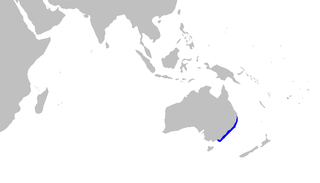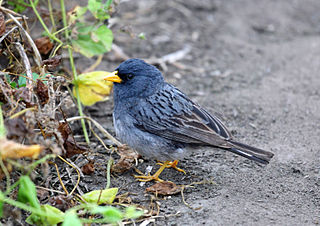
True thrushes are medium-sized mostly insectivorous or omnivorous birds in the genus Turdus of the wider thrush family, Turdidae. The genus name Turdus is Latin for "thrush". The term "thrush" is used for many other birds of the family Turdidae as well as for a number of species belonging to several other families.

Uloboridae is a family of non-venomous spiders, known as cribellate orb weavers or hackled orb weavers. Their lack of venom glands is a secondarily evolved trait. Instead, they wrap their prey thoroughly in silk, cover it in regurgitated digestive enzymes, and then ingest the liquified body.

Tord Tamerlan Teodor Thorell was a Swedish arachnologist.
Asymbolus is a genus of catsharks in the family Scyliorhinidae.

The Australian spotted catshark is a catshark of the family Scyliorhinidae, found only around Australia between 32 and 38°S, at depths between 10 and 180 m. It can grow up to 90 cm. Females of this species were observed as being reproductive year round. They are also confirmed as being a single oviparous species.

The band-tailed seedeater is a species of bird in the family Thraupidae. It is found in Argentina, Bolivia, Chile, Colombia, Ecuador, and Peru. Its natural habitats are subtropical or tropical high-altitude shrubland and heavily degraded former forest.

Spiders are air-breathing arthropods that have eight legs, chelicerae with fangs generally able to inject venom, and spinnerets that extrude silk. They are the largest order of arachnids and rank seventh in total species diversity among all orders of organisms. Spiders are found worldwide on every continent except for Antarctica, and have become established in nearly every habitat with the exceptions of air and sea colonization. As of July 2019, at least 48,200 spider species, and 120 families have been recorded by taxonomists. However, there has been dissension within the scientific community as to how all these families should be classified, as evidenced by the over 20 different classifications that have been proposed since 1900.

Hyptiotes is a genus of spiders in the family Uloboridae.

Hyptiotes paradoxus is a spider species with Palearctic distribution. It is notably found in Lithuania and Latvia. It is also found in Estonia and Finland.
Hyptiotes dentatus is a spider species found in France.

Megaponera analis is the sole species of the genus Megaponera. They are a strictly termite-eating (termitophagous) ponerine ant species widely distributed in Sub-Saharan Africa and most commonly known for their column-like raiding formation when attacking termite feeding sites. Their sophisticated raiding behaviour gave them the common name Matabele ant after the Matabele tribe, fierce warriors who overwhelmed various other tribes during the 1800s. With some individuals reaching up to 25 millimetres (0.98 in) in length, M. analis is one of the world's largest ants.
Ireangelus is a genus of kleptoparasitic spider wasps from the sub-family Ceropalinae of the family Pompilidae. The genus has a pan tropical distribution, being known from Oriental, Neotropical, Australian, eastern Palearctic, and Madagascan Zoogeographic regions being best represented in the Neotropics. Irenangelus is closely related to the more widespread genus Ceropales, the two genera forming a monophyletic subfamily, Ceropalinae within the Pompilidae. This is regarded as the most basal grouping of the Pompilidae but this view is problematic because of the kleptoparasitic life history of the Ceropalines, it is now considered that they Ceropalines and other pompilids evolved from a common ectoparasitoid ancestor.

Tachypompilus is a genus of spider wasps, found in the Neotropics Nearctic, eastern Palearctic, Indomalayan and Afrotropics.

Tachypompilus analis, the red-tailed spider wasp is a species of spider wasp found in most of tropical and subtropical Asia, north to Japan. These spider wasps often hunt huntsman spiders.
Hyptiotes puebla is a species of cribellate orb weaver in the family of spiders known as Uloboridae. It is found in the United States and Mexico.

Hyptiotes gertschi is a species of cribellate orb weaver in the spider family Uloboridae. It is found in the United States and Canada.

Hyptiotes cavatus, the triangle weaver, is a species of cribellate orb weaver in the family of spiders known as Uloboridae. It is found in the United States and Canada. It uses an unusual hunting technique whereby it tightens up an anchor line of the web whilst waiting for prey. This effectively winds up and compresses the web. When prey touches the web, the spider releases the held anchor line, causing the web to spring forwards 2-3cm at high speed. This causes up to 4 additional web strands to touch the prey, and the sudden stop when the web reaches the end of its elasticity then winds the prey further into the strands. This process has analogues to the techniques by humans used to power catapults and ballistae.

Wallis Wood is a 14-hectare (35-acre) nature reserve south-east of Ewhurst in Surrey. It is managed by the Surrey Wildlife Trust.
Josa is a genus of South American anyphaenid sac spiders first described by Eugen von Keyserling in 1891. It is a senior synonym of "Gayenella", "Haptisus", "Olbophthalmus", and "Pelayo".













